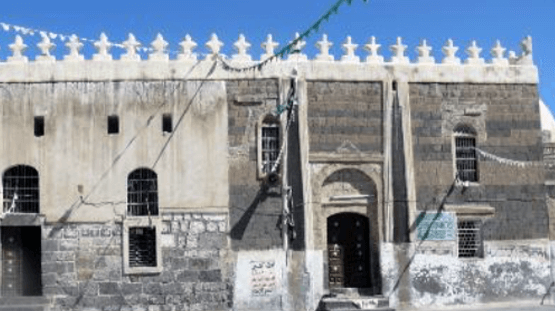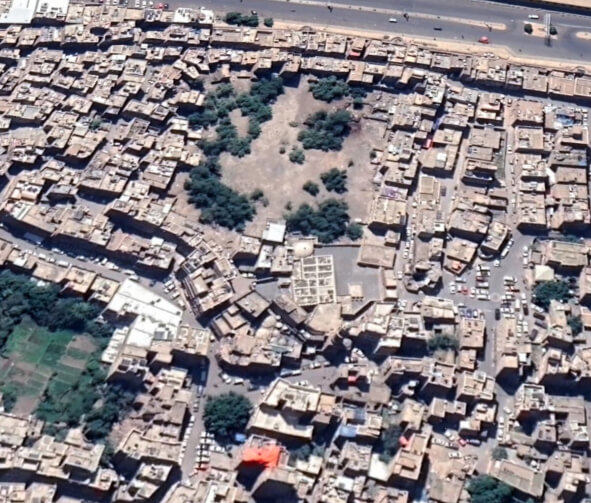
Al-Abhar Mosque – Old Ṣan‘ā’
مسجد الأبهر – صنعاء القديم ة
Monument description
Al-Abhar Mosque was built in Al-Abhar neighborhood, located in the southwest of the Old City of Sana’a. Its plan takes the form of an irregular rectangular. The Mosque is an architectural complex consisting of a Prayer Hall attached to a School from the eastern side of the second floor, built over the Al-Matahir building (Ablution Unit). The Minaret is in the north to it, and constitutes an independent building.
On the west of the Prayer Hall there is an open court, as well as Al-Matahir, parallel to the wall of the Qibla (on the north of the Prayer Hall) and the foundation of the Minaret from the south.

Architectural and cultural value
Construction style and built date: The layout of the Mosque follows the usual style of mosques, with a Prayer Hall in tiles, with a flat roof supported by wooden beams, resting directly on the capitals of stone columns and arches. The construction of the Mosque dates back to the second half of the 8th century AH. It is known as the Mosque of Bint Al-Amir, one of the ancient Mosques. It was built by Fatima, daughter of Prince Al-Assad bin Ibrahim bin Hussein bin Abi Al-Hayja Al-Sarauri, head of the Kurds of Dhamar in the 776 AH (Al-Hijri 2007: 8-9) (1374 CE; Ghilan 2004: 82).
Components of the Mosque: The Mosque consists of: an open court overlooking the Prayer Hall, the Mausoleum dome, and Al-Matahir (Ablution Unit). On the northern side there is the Minaret and the entrance dome, followed, on the southern side of the entrance dome, by a group of rooms belonging to the Mosque. Monument Area is 1430 m2.
- Justifications for intervention:
- 1 – The building has been neglected for lack of funding
- 2 – Preserving the monument and preventing further damage
- 3 – Restoration of damages to the Mosque resulting from the air strikes to the northern part of the Old City of Sana’a
- 4 – Contribute to the restoration of damaged monuments in a proper manner in order to keep Old Sana’a on the UNESCO list.
- Monument conditions:
- The monument is in bad condition, and therefore need surgent restorations:The monument is in bad condition, and therefore need surgent restorations:
1. Cracks in the southern side and a noticeable increase in humidity - 2. The base of the Minaret needs special and urgent maintenance in light of its height. The obvious signs of damage in the Minaret is the crumbling of the brick molds and the impact of the solid plaster niches that decorate the body
- 3. Wavy, fan-shaped cracks in the inner walls and over the corner bends of the Mausoleum dome
- 4. The apparent increase in moisture in the dome’s concave hull, as well as the sediments that begin to be deposited on the epigraphic bands in the inner southern façade due to the intrusion of rainwater from the plaster of the Qamariah
- 5. Erosion of the Qudad layer and inscriptions on the western façade of the Mausoleum dome, theMosque, the external tombs, and the water pool in the open court
- 6. Corrosion of the Qudad layer of the tombs in the external Mausoleums, with damage to the grave stones of the internal and external graves
- 7. Cracks and demolition of the external parts of the pool. Visible cracks in the northern part of the ceiling of the Prayer Hall
- 8. Erosion and disruption of the bonding between the stones in the eastern façade9. Vertical cracks in the Mihrab and blurring of the inscriptions in and around the mihrab.
- Treatment:
- – Removal and rebuilding of the damaged parts of the Mosque using materials identical to the old materials, whether bricks, stones or others
- – Stopping of the vertical expansion of cracks in the affected façades by inserting a thick edge made of wood that limit the vertical expansion of these cracks
- – Cleaning the decorative inscriptions in the different parts of the Mosque, removing the oil paint, completing damaged parts by rebuilding them following the adjacent decorations
- – Restoration of Qudad layers of the Mosque in its various areas and completing the missing parts
- – Completing the dilapidated parts of the pool and repairing cracks on the Qudad layers on the floor and sides of the pool.

Countries










